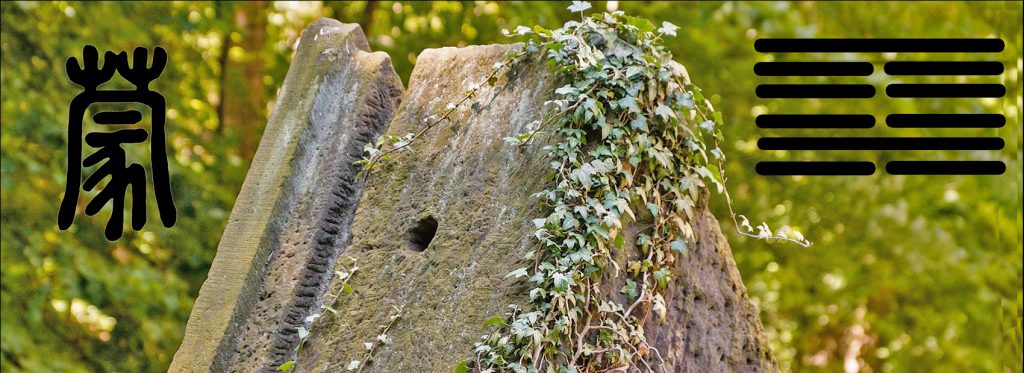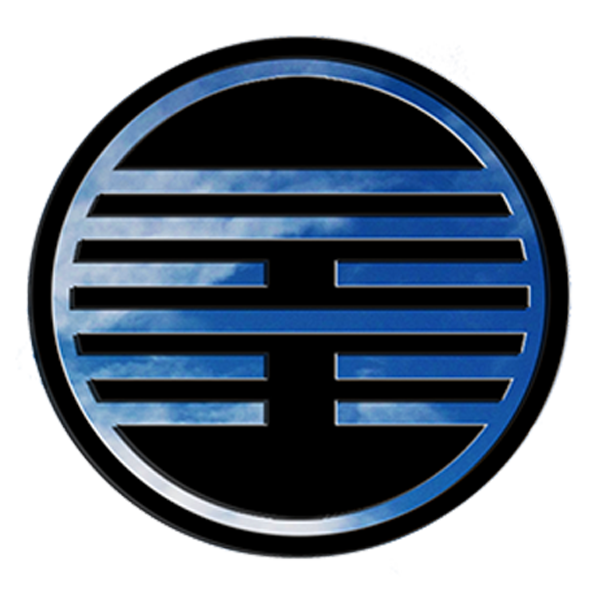Mountain above – Water below
Meng was the Chinese name for a plant that grew prolifically, often covering the roofs of ancient dwellings. The word Meng began to include the idea of covering something up. Meng later came to symbolize the uncovering of obscured wisdom within a child through a process of education. The definition then even further extended to: inexperience, immaturity, innocence, ignorance and foolishness. This hexagram has been titled Youthful Folly, Ignorance, Inexperience, Immaturity and Childhood. The teachings of Meng involve dealing with situations of inexperience (which occur regularly because life is always about resets and new beginnings especially for those who maintain a “beginner’s mindset”) but also include conditions of innocent or willful ignorance.
Breaking down the symbolism of the 3-line trigrams helps with understanding the ancient teachings:

Trigram Water is shown in the image as the bottom 3 lines (below right), representing the inner situation. Water does not have a form but it can fit itself to learn, adapt and absorb. Water is strong, with power to penetrate and shape things. The ancients saw it as a place where emotions are shaped: carrying youthful enthusiasm, the hunger for learning but also fear, insecurity and risk. Without knowledge or maturity, the beginner needs/seeks experience. Water flowing from the base of a mountain is symbolic of the innocent, uninformed mind of a child.
Trigram Mountain is on top of trigram Water as seen in the top 3 lines in the hexagram (below right) and symbolizes the outer situation. Mountain has much to do with defining limits, individuality and stillness. Mountain, as the outer condition here, is symbolic of the rigid, unyielding reality of the world. Mountain may also be seen as the authentic unique individuality of each being, some of which is uncovered in the course of a lifetime.
The ancient ideograph on the upper left portion of the image below is divided into 2 parts. The upper represents “meng”. Meng’s original meaning is associated with a weed that proliferates to cover everything, placing it into the “darkness of ignorance”. The bottom of the ideograph shows a boar (some say jade) which was highly valued in ancient China. Together they form an image of something valuable which needs to be uncovered. The concept is: the child, the ignorant or immature one has yet to have their valuable wisdom uncovered.

In summary: Mountain symbolizes tangible reality (which can be a formidable teacher) and defines one’s place in the world. A spring (Water) at the bottom of the mountain is a small trickle when compared to other large bodies of water, prompting the image of a child. It is at a beginning, not yet joined with a stream and even further from finding a river or ocean to merge with. The ancients saw this beginning as the perfect place to learn how to learn, how to accumulate wisdom by asking questions. It is not wise to seek a teacher to obtain easy but meaningless answers. Wisdom is found in the way one formulates questions; do they move you toward or away from your own inner goals? Not knowing and feeling confused may be a sign of being in the right place when dealing with the archetype of Youthful Folly.
Following are a few ideas for interpretation:
Line 1 – Although there may be a lack of knowledge and some preconceived ideas, it is possible to learn from one’s own blunders. Freedom to experience life’s lessons comes by dropping illusions and strongly held attitudes which can then allow you to walk the middle way between too much or too little discipline.
Line 2 – Caring for others, embracing/accepting “not knowing” or ignorance within others (or within yourself) by allowing it to “be what it is” opens up the ability, as well as the opportunities, to learn and grow. Even when you think you know, being open to the possibility of something else allows for the possibility of discarding or stripping away that which no longer serves well.
Line 3 – There is a danger of losing your individuality and being swayed by people, situations or your own over-reactions. When you place personal authenticity/values foremost, your dignity cannot be lost to those who do not respect you, nor would you allow your own needs to exceed respecting the dignity of others.
Line 4 – Take a look and make sure you are not living unrealistically or in fantasy. Living in reality means making the right choices by seeing what all the choices are. You cannot see all the choices if you wall yourself off from other people.
Line 5 – Complete openness (humility) with no stockpile of ready answers allows for learning and development, leading to good fortune. This type of openness means there is no need to worry about that which is yet beyond your grasp.
Line 6 – There may be a tendency toward extremes of self-will and opinionated thinking resulting in unjust behavior toward others or oneself. The ancient way of correcting a child was rarely through punishing – those who “don’t yet know” do not deserve that. And yet, much can be learned by the sentiment, “As ye sow, so shall ye reap”. Focus on the lessons you are learning by quietly making corrections rather than dwelling on the consequences received through your previous choices.
